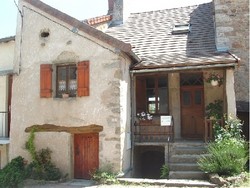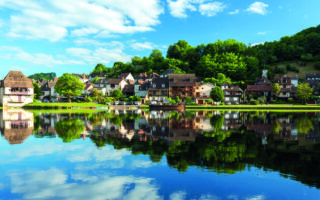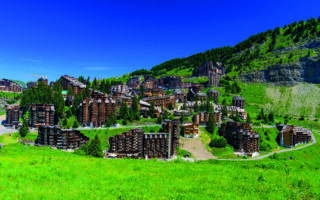Burgundy Property Styles & Where to Buy!


Burgundy, from Wine Growers Cottages to Castles
Most people know Burgundy, thanks only to its wonderful wines or hotels in which they have stayed. However, think of Burgundy and you imediately conjure up images of rolling green hills, rivers, lakes and obviously vineyards. With such varied landscapes, Burgundy offers an incredible wealth of housing styles and possibilities.
Burgundy’s housing archectecture has been dictated over the centuries by land usage and historical change. Burgundy offered in centuries gone by, the richest lands in the whole of France, which explains not only the richly decorated buildings that can be found throughout the whole of Burgundy, but also Burgundy’s incredible gastronomic heritage.
So with Burgundy offering such a wealth of possibilities, the question that you should be asking is which type of house suits you best?
Burgundy Barns
The first step on the Bungundy property market ladder, is a Burgundy barn to be renovated. These are quite easy to find, as almost every farming village house possesses one. They were originally used to house animals during the winter and to stock hay or farm produce. It is unusual to find these barns with a great deal of land since they are often situated a small distance away from the original farmhouse. Barns that are sold with land that affords excellent privacy, are rare comodities and as such are sold quickly. Barns to be renovated start at around 38 000 euros but once renovated can even reach 500,000 euros according to Benjamin Haas, depending on the area and on their general state.
Burgundy Farmhouses
Benjamin also says, “Farmhouses are the most popular variety sold to the foreign market. The standard barn consists of a small living area and an attached barn. The smaller ‘maison’ is used by many as a holiday home, usually a large room, with smaller bedrooms in the back. The attached barn, is much larger, and was previously used for livestock. Today this area is converted into a large living area, for the holiday maker that decides to come and live here”.
Farmhouses in the South
In the Maçonnais area the ‘ferme Maçonnais’ usually consists of two levels with an over hanging roof with tall pillars and round roman tiles ‘tuiles canal’ similar to those found in the south of France. This system of tiles developed because this area of Burgundy tends to have strong but short rain storms (as in the south of France) and these tiles with its chanel system, proved to be the most efficient system for keeping the rain out of the houses.
Farmhouses in the south east Bresse region
The ‘ferme Bressane’ are made typically from crossbeams and bricks or clay and straw walls. Benjamin says that ‘The Saône valley region didn’t have readily available access to stones which explains this building tradition. And the rooves that today have standard red roof tiles were originally thatched’.
Farmhouses in the Morvan
Heading west from Autun in the direction of Nevers, the land becomes more reminiscent of the Highlands of Scotland, as pine forests become the predominant feature of the landscape. The Morvan Regional Park is an area of outstanding natural beauty in the Nièvre.
A haven for lovers of countryside pursuits and for those seeking an antidote to the stresses of modern British life, the area is also perennially popular with the Dutch who have populated it in large numbers for over 10 years.
The geological structure of the area with its granite stone, is reflected in the ‘fermette Morvandelle’ which tends to be smaller than those found in the rest of Burgundy. The grey granite stone was close at hand, and so became the main building material for this region. Black slate rooves and wooden beams from the near by Morvan forest were also put to good use and add rugid caracter to these beautifully pictoresque farmhouses.
Puisaye Farmhouses
Less well known than the Morvan but of equal beauty, “Puisaye farmhouses and cottages make use of local volcanite stone and brick” according to Oliver Aubin, from Puisaye Immobilier. Puisaye was once the site of world renown, with its famous ochre sent even as far away as Russia. Farmhouses here, are alive with the natural colours of the earth and are surrounded by rolling hills. Collete the famous French writer never lost her creative inspiration thanks to Puisaye.
Farmhouses in the north of the Côte D’Or, Chatillion area
Again, farmhouses in this area were built with the region’s natural ressources, limestone. This beautiful yellow/cream coloured stone reminisent of the Cotswolds, makes for cheery and pretty villages. Yellow stone cottages and farms can also be found around Chablis and Vézelay. And this same limestone, is also what has helped give Burgundy its world wide renown for its wonderful Burgundy wines!
Farmhouses and Cottages in wine villages
.JPG)
A typical wine worker’s cottage
Properties in the vineyard villages are hard to come by, as they are sometimes passed hand to hand without ever appearing on the open market. Such is the cachet of the vineyards that houses here are expensive and they are still snapped up if they are on the market at the right price.
It is unsual to say the least to find large farmhouses and cottages together with land or large gardens in wine growing areas, since every centimetre of land is devoted to growing wines. In general houses are packed in tightly in the village centre, almost on top of each other which gives a certain charm. The essential room in the wine grower’s house is obviously the wine cellar. This underground haven of hidden treasures, often with a vaulted stone ceiling with a bare soil floor provides the ideal room in which to mature wines.
Burgundy Mansions
In the rich areas of Burgundy such as Beaune, houses can be autentatious with amazingly coulourful roof tiles. In the 18th and 19th century, in certain areas of the country side, houses ‘maisons bourgeois’, were built quite literally to show-off with by rich mining industrialists Larger farms were also constructed around an inner courtyard to form a ‘U’ shape.
Cities Towns and Villages
You may be lucky enough to find a ‘hotel particulier’ in a town or city that hasn’t yet been divided into separate appartments. These large town houses consist in general of at least 3 and sometimes four storeys. They once belonged to the ‘notable’ and rich high society members of the community. The house consists of a square building and they are richly decorated and have special interior features such as plaster ceiling cornices, oak panelling and solid oak flooring. The same is true of the ‘maison de maître’ to be found in small towns and villages.
The Burgundy Pidgeon House
This pretty feature can be found in many Burgundy farmhouses, mostly on the larger farms though. Again, this was a status symbole for the Burgundian land owners. In the 16th and 17th century the Burgundy nobility were rewarded by the Dukes of Burgundy for their services, with the right to breed pidgeons. This wasn’t for letter delivery though but for meat production! You musn’t forget we’re in Burgundy the site of sacred gastronomy!
Burgundy Castles
You might also be lucky enough to come across a couple of castles on your house hunting trips in Burgundy. The larger farms and wine estates evolved into small castles and folies, again to impress friends and families or to be used as hunting lodges.
So with so much to offer, happy house hunting in Burgundy!
© Jacquie Boulton-Bridoux
Share to: Facebook Twitter LinkedIn Email
More in burgundy, centre, land, renovation, river, villages, wine
By FrenchEntrée
Leave a reply
Your email address will not be published. Required fields are marked *



